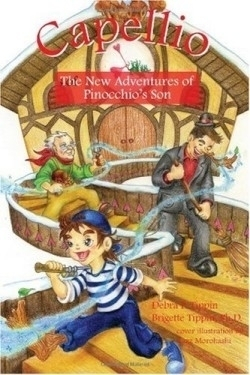Capellio
The boy who started life as a wooden puppet has now become a man. In this freewheeling tale, loosely based on Carlo Collodi’s 1883 classic The Adventures of Pinocchio, a grownup Pinocchio has assumed responsibility for Gepetto’s toyshop, married, and fathered a son, Capellio. While Pinocchio works, Gepetto and Capellio spend their days fishing and enjoying the company of friends. Their carefree lifestyle is disrupted when a dangerous storm moves in and Capellio fails to listen to his father’s safety advice.
Much like the young Pinocchio in Collodi’s tale, Capellio pays a price for his disobedience and becomes separated from his family. His journey home is both guided and derailed by a variety of anthropomorphic characters, many of whom have connections to the original story. Twin sisters Clickety and Clackety are daughters of Gepetto’s friend Mr. Green Cricket, and the mother of Capellio’s special friend Twyla appears to be the “Blue Fairy” who transformed Pinocchio from puppet to boy. Pinocchio is most famous for his nose, which grew each time he told a lie, and his son has inherited this “retrogene” in a slightly different way. When Capellio lies, his legs grow longer.
There are familiar characters and similar themes of obedience and truthfulness, but this story is decidedly lighter and more fanciful than the original classic, with an eco-friendly vibe that permeates the tale. For example, the “Terrible Dogfish” that swallows Gepetto in the original story is reimagined here as Leopold, “a ginormous blue dolphin whaleÂ…a misunderstood gentle giant.” Another character, a sea star named Mr. Starbright, fights pollution by teaching his “starling students” to hook debris from the ocean floor on Gepetto’s fishhook. Much of the story takes place in a fanciful marine environment populated by characters like Rasta Seahorsians, the villainous seawitch, Isabell, and rock star sea star named Matthew G.
Despite a few instances of stilted dialogue, Capellio is decently written, with a swift-moving plot. The circumstances and characterizations may be too trendy or sweet for diehard fans of Collodi’s decidedly darker classic. There are also a few continuity issues between the books, like the fact that the “Talking Cricket” was killed by Pinocchio in the original adventure, but is alive and well in this story. The short length and large typeface make this most appropriate for beginning chapter book readers who will most likely be unaware of such issues.
Disclosure: This article is not an endorsement, but a review. The publisher of this book provided free copies of the book and paid a small fee to have their book reviewed by a professional reviewer. Foreword Reviews and Clarion Reviews make no guarantee that the publisher will receive a positive review. Foreword Magazine, Inc. is disclosing this in accordance with the Federal Trade Commission’s 16 CFR, Part 255.

